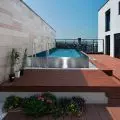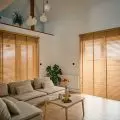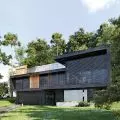Tamizo Architects studio probably doesn't need to be introduced to anyone. Associated mainly with Lodz, it now successfully implements projects throughout Poland and abroad. In almost twelve years of operation, it has developed its recognizable minimalist style. All projects are characterized by extraordinary attention to detail and carefully selected materials, among which concrete and glass are definitely predominant, and are usually accompanied by natural stone and wood, which age beautifully. The tool to create a unique atmosphere and a welcoming space is light, a very important element of any project. Despite the conservative design philosophy, the realizations that are created are completely out of the box, surprising in their simplicity - the author of their concept is Mateusz Kuo Stolarski, founder of Tamizo Architects.
The houses were built on a beautifully situated plot of land in the small village of Viimsi, not far from the Estonian capital. The location combines two very important features: it provides proximity to a large urban center, where cultural and entertainment life is vibrant, once proximity to the airport and all amenities, and at the same time you can wake up amidst unurbanized, green landscapes - as if that wasn't enough, within walking distance of the Baltic Sea!
situation
pic: Tamizo Architects
The area around the houses is overgrown with an evenly trimmed lawn, boulders and towering pine trees appear in places. The plot is partially fenced, but the fence is also consistent with the character of the whole establishment. It is a sequence of massive wooden planks alternately offset from each other, giving the impression of emerging directly from the ground - a contemporary variation on the classic fence. Where there is no fence, the private garden seamlessly transitions into a virgin forest, as seamlessly as the scent of sea breeze and resin mixes here.
The desire to stay close to nature can be seen in almost every design move. It even takes the form of a certain extravagance, as in the case of the openings above the terrace provided for existing trees. While this nod to nature is one of the most distinctive and photogenic elements of the building, it is also difficult in terms of execution, as it requires precision. Note that the light-colored sections of the facade are made of white architectural concrete, and not plastered in white, as it might initially appear. Brilliantly executed architectural concrete appears not only on facades, but also in modern interiors. The realization was fortunate in its careful execution, after all, no one will see to the construction better than the investor himself, who knows his stuff - the owner of one of the houses runs a company specializing in concrete structures, the other is a developer.
To this day, I remember my and my wife's surprise when we stood in front of the buildings and watched them in silence for several minutes. At the time, I think two things were most memorable. The first - the air. The combination of sea and forest climate is indescribable. So clean, so crisp, amazing. The second - the sight of children running and playing in front of the houses. Their carefree, joyfulness perfectly showed how harmoniously the buildings managed to blend into the surroundings. That's when I heard from my wife the phrase "you have to design us a house". I felt the same way, even though we had previously shied away from the idea....
Matthew Kuo Stolarski
Photo credit: Matthew Kuo Stolarski © Tamizo Architects.
The architect strongly emphasizes the great cooperation with these people, and in our conversation, with a certain nostalgia in his voice, he goes back to 2013, when he received the email that started it all. As he admits, those five years ago foreign projects happened much less frequently, so without much enthusiasm potential investors were invited to the meeting. It turned out that they took the invitation very seriously and after just a few days they showed up in Lodz to talk about the details. At that time the office premises were smaller than now, so the conversation took place in one of the pubs on Off Piotrkowska. During the meeting, the most important issues concerning the scope of the project, principles of cooperation and mutual expectations were agreed upon. The form of the advance payment was agreed and the two sides exchanged a handshake. One can only imagine the surprise of Tamizo's owner, who recalls that day this way: "I returned to the office, sat down at the computer and began to tell my co-workers about the meeting - fifteen minutes later the door of the studio opens, my recent interlocutors enter, put a pile of money on the desk in front of me (in front of all the employees, of course) and asked when they would get the concepts? I timidly replied that in about two weeks. They smiled, thanked me, said goodbye and left. I should add that we didn't sign any contract at the time...".
The word was out - after two weeks, the concept for two houses was emailed to Estonia. Only cosmetic changes were made to one of them, the other changed a bit more, as the investor was not convinced by the sloping roofs required by the local plan. However, they managed to push through the flat roof at the office, and after making changes to the original concept, it was time to move on to preparing the construction documentation. It turned out that the not-so-detailed drawings satisfied the investors, and based on them a building permit was obtained, and so in early July 2015 excavators drove onto the forest plot.
Reigo's house; an outdoor kitchen, dining area, sauna or swimming pool are all elements that should form an intergral, albeit outdoor, part of the homes. Hence the need for a large number of covered terraces
Photo: Matthew Kuo Stolarski © Tamizo Architects
The concept began to come to fruition. Two different houses were built, but maintained in the same color scheme and style. The stark white slopes on the facades are warmed by wood-finished elements. In the case of both houses, wood appears on elements that protrude above horizontally stacked blocks of architectural concrete, whether it's gabled cottages synthetically alluding to traditional typology, or emerging perpendicular cubes. Natural wood also covers the outside terraces, and inside it partially covers the floors, and it also appears in the furniture. There is no shortage of it in the framing, either. Large glazings open the house to the surroundings, building a bond between man and nature. What captures the design is the care taken to preserve the existing stand of trees. As already written, this gives an excuse for bold and interesting solutions, both aesthetically and technically.
Reigo house
Photo: Mateusz Kuo Stolarski © Tamizo Architects
Large-scale glazing and irregular openings allow for an interesting play of light, which is one of the key aspects of good design. Here it was possible to control natural light and make it a tool for creating the atmosphere of the place and separating functional zones according to the needs of the householders. For the investors, one of the most important issues was the creation of comfortable and equally important, interpenetrating spaces outside the buildings, between them and in the interiors. This was the impetus for proposing several solids on closed contours, and between them creating a kind of patio - the whole was to be tied together by a common canopy. On a wooded plot it would have been impossible to make one large roof without "victims" in the trees, but the solution turned out to be... irregular holes. This not only cut down as few trees as possible, but also achieved interesting illumination of the interior and exterior activity zones of the residents, including the swimming pool. The shape of the holes in the ceiling was borrowed from the form in which small traffic circles were planned for landscaping.
Mait house
Photo: Mateusz Kuo Stolarski © Tamizo Architects
The architects did not exercise author's supervision over the project. They knew about the receipt of the permit and the start of construction, but did not know the details of how they would proceed. This made Matthew Kuo Stolarski's surprise all the greater when, two years later, he received an invitation to a private chat on one of the social networks. The conversations were held in Estonian, but it was not the words, but the photos that were most important - as you might guess, the photos depicted the implementation of the project! The architect decided to renew contact and suggested a meeting to see the realization and do a photo shoot. The idea was met with great enthusiasm and an invitation to the whole family.
Such a proposal is not rejected - the whole family set out for Estonia. The photos received earlier from a professional session taken by a local company gave some idea, but the reality exceeded the designer's expectations. He had the opportunity not only to see how the building looks, but more importantly how it functions, both by observing and participating in the life of the architecture. He spent several idyllic days at Viimsi with his family, interspersed with sightseeing, sauna, swimming pool and shared meals; they were hosted in the best way they could imagine and treated like best friends. Only positive memories are associated with this place teeming with life and friendly people.
Mait house; however, the biggest challenge was to reconcile the designed buildings with the trees growing on the plots. That's when the idea of canopies with large openings in the center that did not interfere with the greenery came up.
Photo: Matthew Kuo Stolarski © Tamizo Architects
The project was not only appreciated by the most important jurors - the users themselves - but was also recognized as the best project erected in Estonia using concrete, winning the Grand Prix in the Aasta Betoonehitis 2017 competition. In comparison, the earlier edition was won by the Eesti Rahva Muuseum in Tartu.
It remains to keep our fingers crossed for further successes in Estonia, because everything indicates that Tamizo's cooperation with these investors will continue, and as this example shows, good cooperation between architect and investor brings great results and satisfaction to both parties.

































































